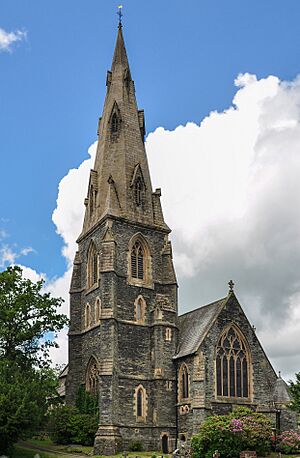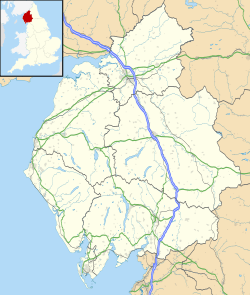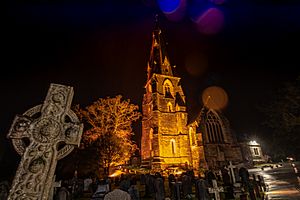St Mary's Church, Ambleside facts for kids
Quick facts for kids St Mary's Church |
|
|---|---|
 |
|
| 54°25′51″N 2°58′00″W / 54.430848°N 2.966588°W | |
| Location | Ambleside |
| Country | England |
| Denomination | Church of England |
| Website | amblesidechurch.org.uk |
| Architecture | |
| Heritage designation | Grade II* |
| Architect(s) | George Gilbert Scott |
| Style | Gothic Revival |
| Years built | 1850s |
| Administration | |
| Archdeaconry | Westmorland |
| Diocese | Carlisle |
| Province | York |
St Mary's Church is a beautiful old church located in Ambleside, Cumbria, England. It was built in the 1850s. A famous architect named George Gilbert Scott designed it. The church is built in a style called Gothic Revival. This style looks like old medieval churches.
One special part of St Mary's is its tall stone spire. This spire is a well-known landmark in the Lake District. It's also unusual for churches in this area. The church is made from local slate stone. Sandstone was used for decorations and the spire. The building is considered very important. It has a special heritage listing called Grade II* listed.
Contents
A Look Back: The Church's History
St Mary's Church was built because Ambleside started to grow. This happened after the railway arrived in Windermere in 1847. More tourists began visiting the area. This led to Ambleside expanding.
Later, in 1889, a new room was added to the church. This room was a choir vestry. It was designed by architects named Paley & Austin.
Inside the Church
The Amazing Wall-Painting
On the west wall of the church, there is a huge painting. It is 26 feet long! This painting shows a traditional ceremony. It is called rushbearing. This ceremony still happens every year. It takes place on the first Saturday in July.
The painting was created by Gordon Ransom. He was from the Royal College of Art. The college moved to Ambleside during the Second World War. The vicar (church leader) of Ambleside at the time, Henry Adamson Thompson, is shown in the painting. You can see him on the right side.
The Church Bells
The church tower holds a set of eight heavy bells. They were made in 1901. A company called John Taylor & Co in Loughborough cast them. The largest bell weighs over 1,650 kilograms. That's like a small car!
These bells are very special. They are the fourth heaviest set of eight bells in the United Kingdom. They are also the heaviest set outside of the West Country. You can hear the bells ringing from across Lake Windermere. Many people think they are among the best bells of their kind in the UK.
Burials at St Mary's
Several notable people are buried at St Mary's Church. One of them is Mary Louisa Armitt. She was the person who started the Armitt Library in Ambleside. Her sisters, Annie and Sophia, are also buried there.




